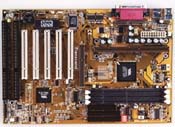Transcend TS-AVD1 VIA Apollo Pro 133 Slot-1 ATX
by Elliott Lee Hazen on November 27, 1999 2:41 PM EST- Posted in
- Motherboards
Transcend is a motherboard company that has been around for a while, but it is still not very well known. They focus on two different components -- motherboards and memory -- an uncommon combination. Transcend claims to put the customer above all, so let's see if this board, the TS-AVD1, is able to meet the consumer demand and be a competitor in the tight motherboard market.
New Anand Tech Report Card Rating 83/C
| CPU Interface |
Slot-1
|
| Chipset |
Apollo Pro 133
|
| L2 Cache |
N/A (on-chip)
|
| Form Factor |
ATX
|
| Bus Speeds |
66
/ 68 / 75 / 83 / 95 |
| Clock Multipliers |
3.5x - 8.0x
|
| Voltages Supported |
Autodetect
|
| Memory Slots |
3 168pin DIMM Slots
|
| Expansion Slots |
0 AMR Slots
1 AGP Slot 5 PCI Slots (4 Full Length) 2 ISA Slots (1 Shared / 1 Full Length) |
| BIOS |
Award 4.51PG
|
The Good
The Transcend TS-AVD1 boasts VIA's Apollo Pro 133 chipset -- allowing for official 133 MHz FSB operation and ATA 66 support. Like the previously reviewed Apollo Pro 133 boards, the Transcend TS-AVD1 has a predecessor, the TS-ABX. The two boards are virtually identical, except that the TS-AVD1 uses the Apollo Pro 133 instead of the BX. In fact, the TS-AVD1 has the TS-ABX name silk screened on its PCB.
The layout of the TS-AVD1 is almost identical to the TS-ABX, which means just one minor deviation from the ATX specification -- the placement of the power connector behind the Slot-1 connector. This configuration adds to case clutter by forcing the power cable to run over the CPU and memory slots. Fortunately, it is at the right edge, rather than directly behind the CPU. The floppy drive and the HDD connectors are located where they should be, right at the front of the board. The board is of average length, just a bit longer than an ISA slot, which means it should fit fine in any ATX case.
There are ten 1500uF capacitors, located immediately around the Slot-1 connector, with a few other capacitors placed sparsely all over the board. There is a purple heatsink placed on VIA's VT82C693A North Bridge Controller. A pre-installed fold down CPU retention mechanism comes on the board and will hold any Celeron, Pentium II, or Pentium III CPU. The Mobile South Bridge VT82C596B chip, which allows for UDMA 33/66 support on both IDE channels, is located in front of the PCI slots. The TS-AVD1 boasts the ever-popular 5/2/1 (PCI/ISA/AGP) slot configuration as well as 3 DIMM slots for memory expansion. A set of DIP switches near the DIMM slots for setting the clock multiplier, but these switches are only important for running older, unlocked CPUs.
The TS-AVD1 offers a mostly jumperless FSB setup. For the overclockers, check in the top right of the Chipset Features menu to find control over FSB speeds. FSB settings of 66 / 68 / 75 / 83 / 95 / 100 / 112 / 117 / 124 / 133 / 138 / 140 / 150 are all available, but they must correspond to the jumpers switches. For example, if you want to run a 66 MHz CPU at 100 MHz, the jumpers must be set for 100 MHz to force the chip to a higher FSB. For overclockers, there are not as many FSB options as some competing boards. The BIOS has a setting for a 1/4 PCI multiplier for the FSB speeds that need it. The rest of the BIOS is the typical AWARD fare.
The Transcend offers three easily accessible 3-pin fan connectors for using monitored fans -- one by the CPU slot, one by the DIMM slots, and one right in front of the ISA slots. It also sports the Winbond 83781D chip just like the i440BX TS-ABX. This chip monitors all three onboard fans, 7 voltages, and up to 3 temperatures. Alone, the Winbond hardware monitor can only monitor one temperature -- the temperature of the Winbond chip itself. In order to monitor other temperatures, such as that of the CPU, an external thermistor is required. Transcend has included a thermistor mounted directly in front of the Slot-1 connector for monitoring CPU temperature. It is raised above the surface of the board so that it should touch the bottom of the CPU's heatsink. Unfortunately, however, there are no other thermistor headers provided, so that "up to 3 temperatures" is cut down to just two. No hardware monitoring software was included with the board, but there is one available for download from Transcend's website. Of course, a variety of shareware/freeware hardware monitoring utilities are available on the web, such as Motherboard Monitor and Hardware Monitor.
The power management options are typical. For the users who wish the computer to turn on in the presence of network activity or an incoming, both wake on LAN and wake on modem ring headers are available. Also, the BIOS can be set to turn on the system at a specific time so the computer can wake up before you. The CPU fan can be shut off when the system suspends to quiet things down a bit. ACPI support is built into the BIOS for added power management under an ACPI compliant OS like Windows 98 or Windows 2000. The system can be configured to power on via hot key or mouse click as well.











0 Comments
View All Comments